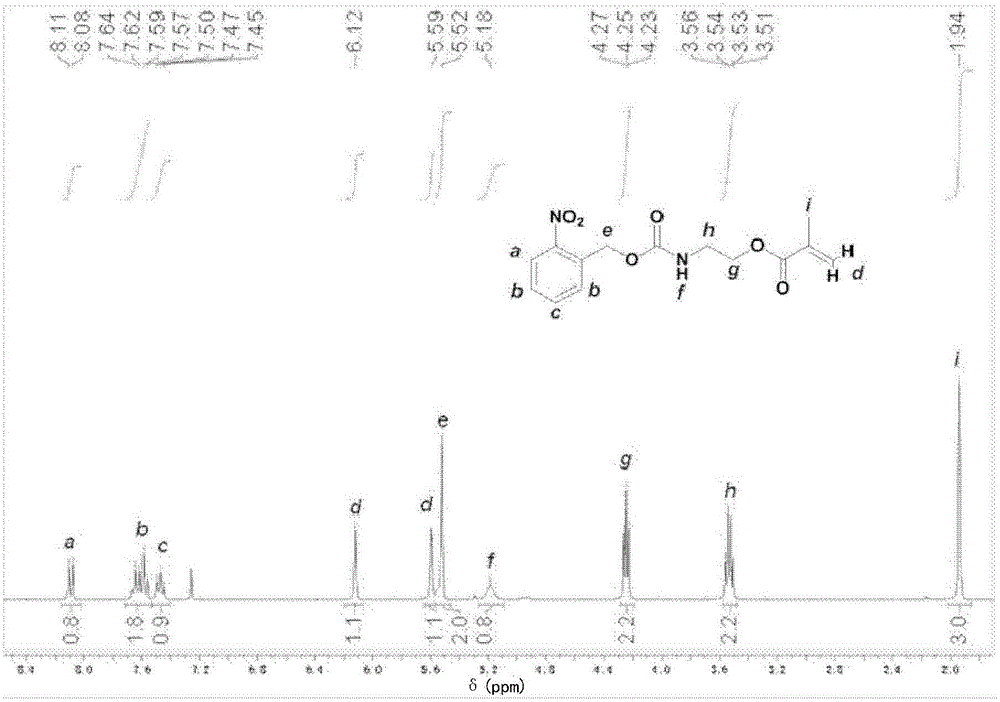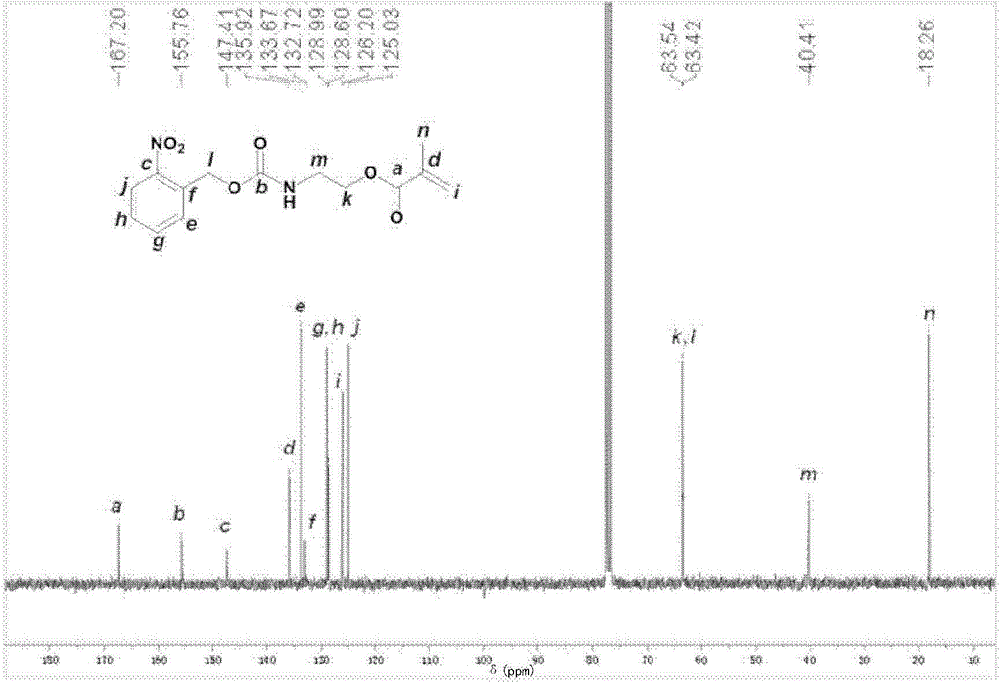Amphiphilic block polymer, polymer vesicle, preparation method and application thereof
An amphiphilic block, polymer technology, used in capsule delivery, microcapsules, nanocapsules, etc.
- Summary
- Abstract
- Description
- Claims
- Application Information
AI Technical Summary
Problems solved by technology
Method used
Image
Examples
preparation example 1
[0052] In the first step, prepare the following hydrophobic monomer M1 (ie m=1):
[0053]
[0054] It is characterized in that: the primary amine protected by the o-nitrobenzyloxycarbonyl group can undergo a rearrangement reaction under ultraviolet light conditions to remove a molecule of o-nitrobenzaldehyde and CO 2 , and release a primary amine.
[0055] Preparation method: Dissolve 3.0g (19.6mmol) of o-nitrobenzyl alcohol in 60mL of dry tetrahydrofuran, add a catalytic amount of dibutyltin dilaurate (DBTL, 50 μL) to it, and slowly add 4.56g ( 29.4 mmol) isocyanoethyl methacrylate. After reacting for 4 hours, the organic solvent was removed by rotary evaporation under reduced pressure. The residue (crude product) was dissolved in dichloromethane, washed three times with saturated brine, and dried over anhydrous magnesium sulfate. Then the crude product was concentrated by rotary evaporation, purified by column chromatography (basic aluminum oxide was the stationary phas...
preparation example 2
[0080] In order to investigate the relationship between the assembly result of the amphiphilic block polymer and the choice of co-solvent, the inventors selected different co-solvents, and as a result, vesicle structures of different sizes (100-2000 nm) could be obtained. When acetone was used as the co-solvent, vesicles (V2) with a diameter of about 300 nm were obtained in the same manner as in Preparation Example 1 with other parameters unchanged.
[0081] Specific assembly process: 50 mg of P1 polymer was dissolved in 10 mL of acetone co-solvent, and 90 mL of ultrapure water was added thereto at a rate of 10 mL / h under stirring at room temperature. The obtained whitish emulsion was placed in a dialysis bag, dialyzed in water, and the organic solvent was removed after dialysis for 12 hours. Thus, a vesicle (V2) with a diameter of about 300 nm was obtained, and its TEM photo is as follows Figure 12 shown.
preparation example 3
[0083] Using the water-in-oil-in-water (W / O / W) double emulsification method, the inventors can also conveniently obtain large vesicles (V3) with a micron size (2-10 μm). In order to visually study the hydrophobic-hydrophilic transition of the vesicle bilayer membrane, a polarity-sensitive probe (Nile red) was added to the preparation of large vesicle V3.
[0084] The specific preparation process is as follows: Dissolve 10mg of polymer P1 and 0.1mg of Nile Red in 5mL of chloroform, add 0.5mL of ultrapure water under ultrasonic conditions of the probe, and then add this suspension to 25mL of ultrapure water under ultrasonic conditions of the probe , chloroform was removed by rotary evaporation under reduced pressure, and the large vesicle V3 loaded with the polar fluorescent probe in the hydrophobic layer was obtained. Figure 13 The laser confocal micrographs (scale bar is 2 μm) of the large vesicle V3 (loaded with the polarity-sensitive fluorescent probe Nile Red) during the i...
PUM
| Property | Measurement | Unit |
|---|---|---|
| size | aaaaa | aaaaa |
| thickness | aaaaa | aaaaa |
| wavelength | aaaaa | aaaaa |
Abstract
Description
Claims
Application Information
 Login to View More
Login to View More - R&D
- Intellectual Property
- Life Sciences
- Materials
- Tech Scout
- Unparalleled Data Quality
- Higher Quality Content
- 60% Fewer Hallucinations
Browse by: Latest US Patents, China's latest patents, Technical Efficacy Thesaurus, Application Domain, Technology Topic, Popular Technical Reports.
© 2025 PatSnap. All rights reserved.Legal|Privacy policy|Modern Slavery Act Transparency Statement|Sitemap|About US| Contact US: help@patsnap.com



